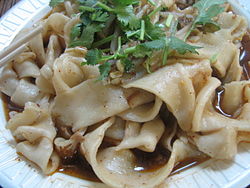You can help expand this article with text translated from the corresponding article in Chinese. (September 2020) Click [show] for important translation instructions.
|
 | |
| Type | Chinese noodles |
|---|---|
| Place of origin | China |
| Region or state | Shaanxi |
| Biangbiang noodles | |||||||||||||||||
|---|---|---|---|---|---|---|---|---|---|---|---|---|---|---|---|---|---|
| Traditional Chinese | 𰻞𰻞麵 / | ||||||||||||||||
| Simplified Chinese | 𰻝𰻝面 / | ||||||||||||||||
| Hanyu Pinyin | biángbiáng miàn | ||||||||||||||||
| |||||||||||||||||
| Alternative Chinese name | |||||||||||||||||
| Traditional Chinese | 油潑扯麵 | ||||||||||||||||
| Simplified Chinese | 油泼扯面 | ||||||||||||||||
| Hanyu Pinyin | yóupō chěmiàn | ||||||||||||||||
| Literal meaning | oil-splashed hand-pulled noodles | ||||||||||||||||
| |||||||||||||||||
Biangbiang noodles (simplified Chinese: 𰻝𰻝面; traditional Chinese: 𰻞𰻞麵; pinyin: Biángbiángmiàn), alternatively known as youpo chemian (simplified Chinese: 油泼扯面; traditional Chinese: 油潑扯麵) in Chinese, are a type of Chinese noodle originating from Shaanxi cuisine. The noodles, touted as one of the "eight curiosities" of Shaanxi (陕西八大怪),[1] are described as being like a belt, owing to their thickness and length.
Biangbiang noodles are renowned for being written using a unique character.[2] The character is unusually complex, with the standard variant of its traditional form containing 58 strokes.
- ^ Zhang, Megan. "The Chinese noodle dish whose name doesn't exist". www.bbc.com. Archived from the original on 20 July 2022. Retrieved 10 May 2022.
- ^ "A Taste of Xi'an in North London". Fuchsia Dunlop. 10 July 2015. Archived from the original on 28 May 2023. Retrieved 14 June 2016.